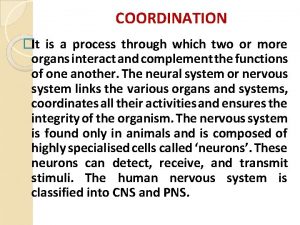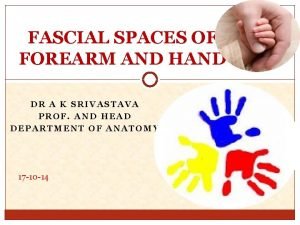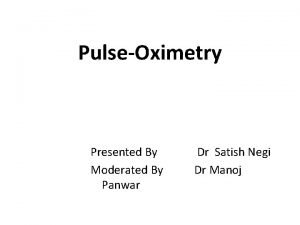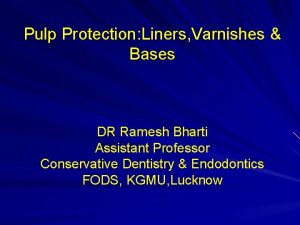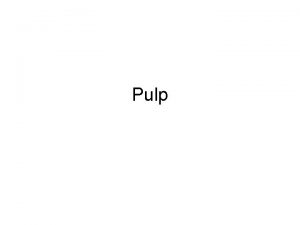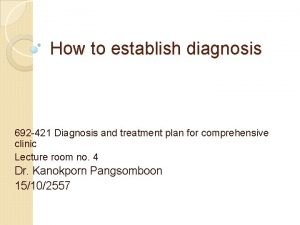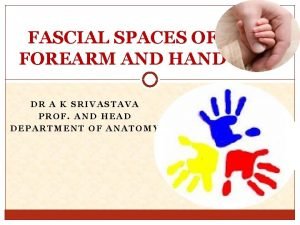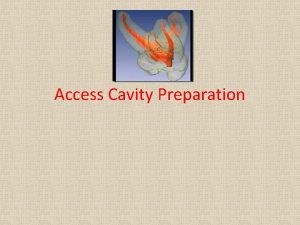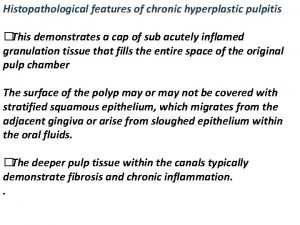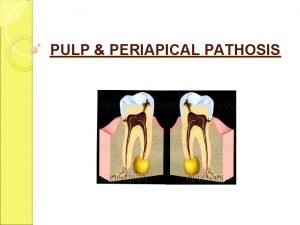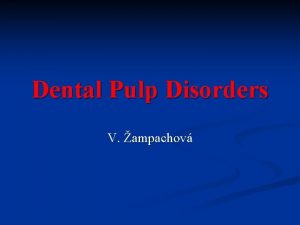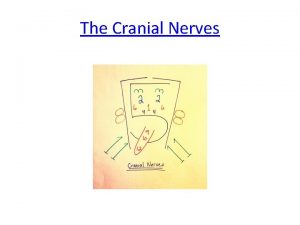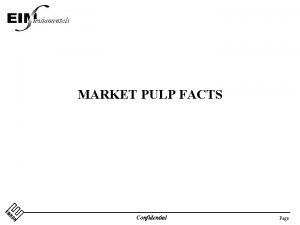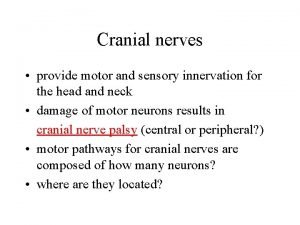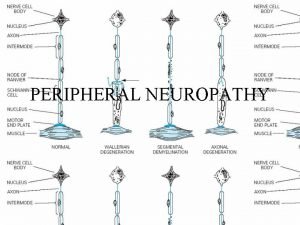Dental Pulp Innervation Unmyelinated nerves Myelinated nerves except

















- Slides: 17

Dental Pulp Innervation

Unmyelinated nerves Myelinated nerves (except for C-fiber) Fast Slow

INNERVATION - mostly afferent sensory innervation

Plexus of Raschkow (Unmyelinated nerves)

Myelinated nerves (25%) • 90% A-Delta (A ) • 10% A-Beta (A ) Un-myelinated nerves (75%) • C-fiber Remember: After leaving Raschkows plexus, most fibers have lost their myelination

Pulpal nerve fibers Sensory fiber Afferent Sensation Terminal sites A Vibration Mechanoreceptor Dentin Pre-dentin Od layer A , fast Pre-pain, sharp Dentin Pre-dentin Od layer A , slow Ache Od layer ? Pulp: CRZ Pulp: Deep CT C, polymodal/C Ache Od layer ? Pulp: CRZ Pulp: Deep CT Myelinated (25%) Un-Myelinated (75%) Sympathetic fiber Efferent C Blood vessels Pulp: Deep CT Od = Odontoblasts CRZ = Cell rich Zone CT = Connective tissue Byers, MR et al. , Dental Plasticity and Nerve Regeneration (2003)

Unmyelinated nerves Myelinated nerves (except for C-fiber) Fast Slow

Locations of afferent sensory nerve endings in Crown Pulp 1. 2. 3. Locations: 1. Dentin 2. Predentin 4. 3. Odontoblast layer 1. Deep pulp core M. Byers

Locations of afferent sensory nerve endings in Crown Pulp 1. 2. A , A 3. Locations: A , (C) 1. Dentin 2. Predentin 4. 3. Odontoblast layer C 1. Deep pulp core M. Byers

Dentinal tubules 1. Process from Odontoblasts 2. Process from Dendritic cells 3. A nerve fibers 4. A fast nerve fibers 5. Fluid

Sensory nerve OB process TC Oral Histology, Fig. 8 -63 Fluid

Assessment of tooth vitality/sensitivity

Assessment of tooth vitality/sensitivity • Measures (extrapolates) pulp health from a sensory response • Thermal • A fibers • Hot (C-fibers) • Heated guttaperka point • Cold • Refrigerant spray • Electrical stimuli causes an action potential in myelinated nerves (Nodes of Ranvier); Raschkow’s plexus

Section

Chapter 7: Frame 10: Pulpal sensory innervation Sensory innervation. Overview of the normal sensory innervation in a rat molar. Due to the normal synthesis and presence of neuropeptides within sensory axons and nerve endings in the dental pulp, both sensory nerves (axons) and their nerve endings can be visualized using immunocytochemistry. Here, an antibody to calcitonin gene-related peptide (CGRP) is used. SP and CGRP are examples of neuropeptides that are synthesized by sensory nerves within the dental pulp. They are stored within the nerve ending, and secreted upon noxious environmental stimuli, creating a neurogenic inflammatory response. As seen in these images, sensory nerve endings are concentrated in crown pulp and especially in dentin (arrows) underlying enamel (en). Tertiary dentin (RD) and furcation dentin (*) are poorly innervated. A nerve fiber entering the root (panel a) is indicated (A-arrow). Panel b includes some of the region from the upper right in panel a (dotted lines). Scale bars: 0. 5 mm(a), 0. 1 mm (b). (From Byers, in Dentin Pulp Complex, M. Shimono et al. eds, Quintessence Publ. , Japan, pp. 124 -129, 1996).

Question

Bleaching of teeth is very popular, but often leads to intense hypersensitivity. A. In the paper by Kenneth Markowics, what does he hypothesize as the cause behind this type of sensitivity? A. What is the main difference between bleaching sensitivity and dentin sensitivity?
 Label the features of a myelinated axon
Label the features of a myelinated axon Myelinated nerve fiber
Myelinated nerve fiber Cell free zone
Cell free zone Pulp fiction
Pulp fiction Rcp pulp
Rcp pulp Polish joke
Polish joke Celesa pulp
Celesa pulp Spaces of hand
Spaces of hand Pulp oximeter
Pulp oximeter Liners and bases in dentistry
Liners and bases in dentistry Indirect pulp capping
Indirect pulp capping Cell-free zone of weil
Cell-free zone of weil White pulp
White pulp Pulp diagnosis
Pulp diagnosis Palmar fascial spaces
Palmar fascial spaces Definition of access opening in endodontics
Definition of access opening in endodontics Chronic hyperplastic pulpitis
Chronic hyperplastic pulpitis Periapical granuloma vs abscess
Periapical granuloma vs abscess

